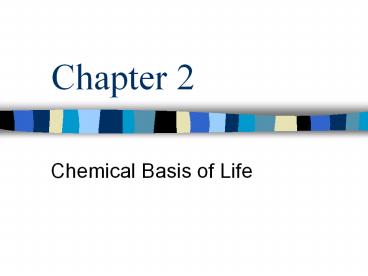Chemical Basis of Life - PowerPoint PPT Presentation
1 / 30
Title: Chemical Basis of Life
1
Chapter 2
- Chemical Basis of Life
2
I. Elements Matter
- Matter
- - Matter refers to anything that has mass and
takes up space. - - Atoms are the smallest particles of matter.
3
Elements and Atoms
- B. Elements
- 1. All matter is composed of elements
- 2. Elements are the basic substances that make
up matter - 3. Atoms are the smallest particles of matter
- 4. Living Organisms require about twenty
elements - 95 of human body is made of oxygen, carbon,
hydrogen, and nitrogen
4
Carbon, hydrogen, oxygen, and nitrogen Make up
the bulk of living matter
0
Table 2.1
5
- 5. Trace elements are common additives to food
and water - Dietary deficiencies in trace elements can cause
various physiological conditions
0
Figure 2.2B
Figure 2.2A
6
C. Atomic Structure
- 1. Protons ()
- 2. Neutrons (neutral)
- 3. Electrons (-)
7
- 4. Electron arrangement determines the chemical
properties of an atom - 5. Are arranged in shells, which may contain
different numbers of electrons - 1st- 2 electrons 2nd- 8 electrons
- 3rd- 18 electrons 4th- 32 electrons
0
8
Drawing Bohr Models of Atoms
9
D. Periodic Table of Elements
10
Periodic Table of Elements
11
How many protons, neutrons, and electrons?
- Step 1
- Use your periodic table to find and element.
- Step 2
- The number of protons ( charge)
- The atomic number 36
- Kr has 36 protons
12
- Step 3
- The number of electrons (- charge)
- Remember atoms have no overall charge
- Atoms must have an equal number of protons and
electrons - Number of protons number of electrons
- Kr has 36 electrons
13
- Step 4
- The number of neutrons (neutral/no charge)
- Mass number (atomic weight rounded to the nearest
whole number) - Neutrons mass number protons
- Kr neutrons 84 36 48
14
- Summary
- Number of protons atomic number
- Number of electrons protons
- Number of neutrons
- mass number protons
15
- Problems
- Find the protons (p), electrons (e-), and
neutrons (n) of Oxygen.
16
- Problems
- Find the p, e-, n of Xenon (Xe).
17
- Problems
- Find the p, e-, and n of Zirconium (Zr).
18
E. Atom Rules
- of Protons Atomic number
- of Protons of Electrons
- Mass Protons Neutrons
Symbol Atomic Mass p n e-
U 92 192
Na 11 23
Mg 24
Cu 65
19
F. Isotopes
- 1. Isotopes have a different number of neutrons
but the same number of protons - 2. Radio active isotopes are used to detect
problems with the thyroid, treat cancer, and
detect problem with digestion
20
- Isotopes
0
Table 2.4
21
G. Molecules and Compounds
- 1. Molecule when two or more atoms combine
(usually for nonmetals) - 2. Compound when two or more atoms of different
elements combine - Two types
- Ionic
- Covalent
22
- 3. Elements can combine to form compounds
0
23
II. Bonding
- A. Atoms whose shells are not full, tend to
interact with other atoms and gain, lose, or
share electrons. These interactions form chemical
bonds
24
B. Types of Bonding
- 1. Ionic
- A metal and non metal
- Form ions
- Na
- O2-
- Transfer of electrons
- Ionic compounds
- Ions are important muscle contraction, nerve
impulse transmission, etc.
25
- Ionic bonds are attractions between ions of
opposite charge
0
Figure 2.7A
26
- 2. Covalent
- 2 or more non metals
- Sharing of electrons forms a bond.
- Single double or triple
- Molecules formed when two or more atoms combine
27
0
28
- C. Unequal electron sharing creates polar
molecules - A molecule is nonpolar
- When its covalently bonded atoms share electrons
equally
0
29
- In a polar covalent bond
- Electrons are shared unequally between atoms,
creating a polar molecule
0
30
- C. Hydrogen Bond
- Occurs when an atom of hydrogen has a strong
attraction to two atoms instead of one - The atoms must be highly electronegative
(electron loving) like Oxygen, Flourine,
Nitrogen, Chlorine and Bromine

